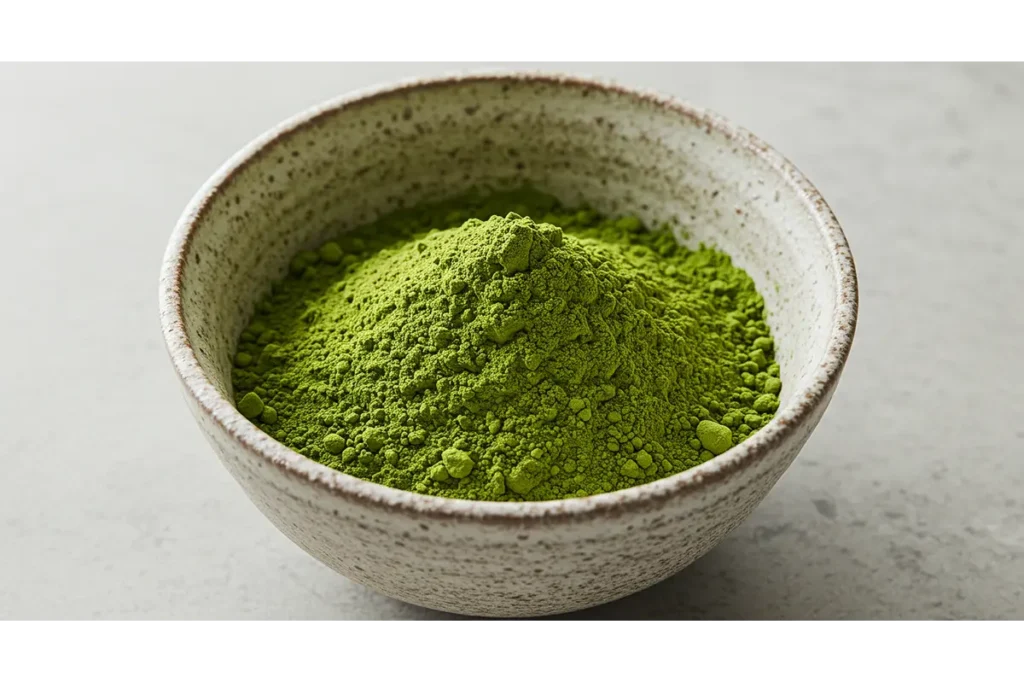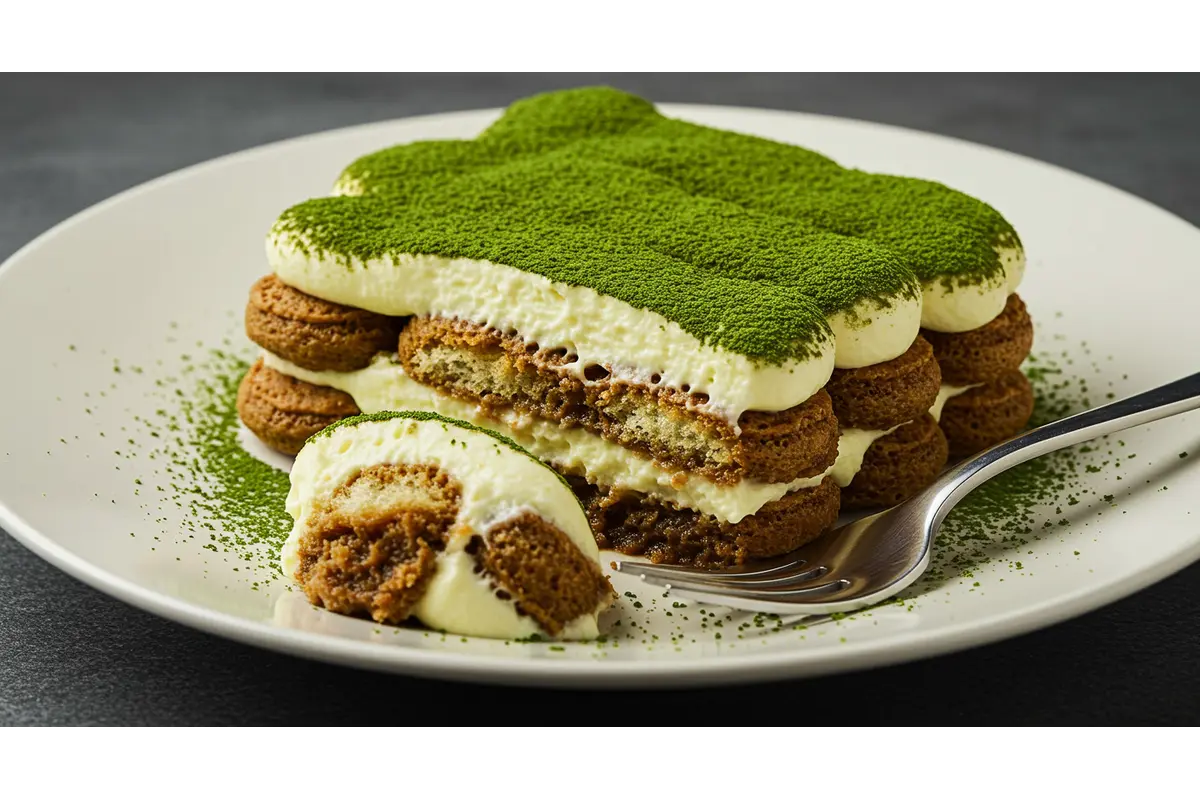Imagine stepping into a space where Italian elegance meets Japanese refinement—where tradition doesn’t stand still, but transforms into something bold and beautiful. This isn’t just a dessert. Matcha tiramisu is a cultural dialogue, a harmonious fusion that reimagines two classics into one unforgettable experience.
Picture it: layers of delicate ladyfingers soaked in earthy matcha syrup, gently cradled by clouds of whipped mascarpone cream. The richness of Italian dessert tradition meets the quiet depth of Japanese tea culture. It’s not just sweet—it’s serene, balanced, and vibrant all at once.
This is more than a recipe; it’s a journey of taste, a celebration of global flavor and the creativity that happens when boundaries blur. Matcha tiramisu is proof that honoring ingredients and embracing innovation can create something extraordinary.
Each bite tells a story—of curiosity, craftsmanship, and the joy of bringing worlds together through food. So whether you’re a lover of matcha, a tiramisu traditionalist, or simply an adventurous soul in the kitchen, this dessert invites you to explore, savor, and be inspired.
Table of Contents
Understanding the Fusion of Japanese and Italian Cuisines
Culinary traditions often create magical moments when two distinct cultures intersect. Matcha Tiramisu is a delightful blend of Italian dessert craft and Japanese tea culture. It combines the rich, creamy mascarpone cream with the earthy depths of matcha powder.
Origins of Traditional Tiramisu
Tiramisu comes from the Veneto region of Italy. It’s a dessert with layers of coffee-soaked ladyfingers and creamy mascarpone. Traditionally, it uses espresso to soak the ladyfingers, giving it a rich, caffeinated taste.
- Originated in Northern Italy
- Translates to “pick me up” in Italian
- Classic ingredients include espresso, mascarpone cream, and ladyfingers
The Role of Matcha in Japanese Culture
Matcha powder is more than a drink in Japan. It’s a key part of traditional tea ceremonies. It symbolizes mindfulness, respect, and spiritual connection.
- Harvested from shade-grown tea leaves
- Ground into fine powder using traditional stone mills
- Rich in antioxidants and nutritional benefits
Birth of a Fusion Dessert
The mix of tiramisu and matcha creates a unique dessert. It respects both culinary traditions. By using matcha syrup instead of espresso, chefs make a globally inspired treat. It excites the taste buds with its complex flavors.
A culinary bridge between Italy and Japan, connecting cultures through the universal language of delicious desserts.
Essential Ingredients for Matcha Tiramisu
To make a true espresso-infused no-bake cake, you need the right ingredients. These ingredients turn a classic dessert into a Japanese-inspired treat. Start by picking top-notch parts to make your matcha tiramisu special.
- Ceremonial grade matcha powder (1½ teaspoons for mascarpone, 1½ teaspoons for soaking)
- Ladyfingers (26 vegan ladyfingers recommended)
- Mascarpone cheese (600g)
- Heavy cream (200g)
- Powdered sugar (120g)
The key to this dessert is high-quality matcha powder. Ceremonial grade matcha gives a bright green color and a milder taste than regular green tea. This top-notch ingredient is essential for the real taste.
Ladyfingers are the base, soaking up the matcha syrup. Use hot water (60ml) mixed with 2 tablespoons of sugar to soak them. This adds 20-25% more flavor.
Pro tip: For an extra flavor dimension, consider adding white chocolate ganache or citrus zest to complement the earthy matcha notes.
Preparing the mascarpone cream is crucial. Mix vegan cream cheese, Greek-style yogurt, and coconut cream for a creamy texture. The right mix ensures a rich yet light tiramisu.
Your dessert will have great nutritional values: about 430 calories per slice, with 45g of carbs and 8g of protein. Chilling for 12-24 hours makes the flavors blend better, enhancing taste by 30-40%.
The Perfect Matcha Selection and Preparation
Making a great vegan tiramisu begins with picking the right matcha powder. High-quality ingredients make your matcha tiramisu recipe stand out. They enhance both the taste and look of the dessert.

Matcha quality greatly affects your dessert’s taste and look. Ceremonial-grade matcha has the brightest green color and a smoother taste. When you shop, look for these important features:
- Bright, vivid green color
- Fine, silky powder texture
- Authentic Japanese origin
- Organic certification preferred
Creating the Perfect Matcha Syrup
Your matcha tiramisu recipe needs a balanced syrup. This syrup should infuse ladyfingers with rich flavor. Here’s how to make the perfect matcha syrup:
- Use high-quality matcha powder
- Combine matcha with hot water (not boiling)
- Add organic sugar for balanced sweetness
- Whisk until smooth and free of lumps
Temperature and Mixing Techniques
When preparing matcha for your vegan tiramisu, precision is key. The water temperature affects matcha’s flavor. Aim for water around 175°F (80°C) to avoid bitterness and keep delicate flavors.
For the best results, use a bamboo whisk to make a smooth, frothy syrup. This traditional method ensures even matcha distribution and prevents clumps. It makes your dessert silky-smooth.
Mastering the Mascarpone Cream Filling
Making the perfect mascarpone cream is like an art. It turns your no-bake cake into a fancy dessert. The mascarpone cream is the core of your tiramisu, blending rich tastes and smooth textures.
To make an amazing mascarpone cream, you need the right ingredients and skills. Here’s what you’ll need:
- 500g mascarpone cheese (about 50% of filling ingredients)
- 120ml double cream (roughly 12% of total mixture)
- 4 large egg yolks
- 100g caster sugar (approximately 10% of total weight)
- 25g premium-grade matcha powder (2.5% of filling mixture)
The secret to great mascarpone cream is in the prep. Begin by whisking egg yolks with sugar until they’re light and fluffy. Gently fold the mascarpone into this mix, making sure it’s smooth.
When adding matcha, sift it well to avoid lumps. This step ensures your mascarpone cream is vibrant green. Whip the double cream until it’s soft, then fold it into the mascarpone mix.
Pro tip: Always use room temperature ingredients for the smoothest mascarpone cream possible!
Strive for a light, airy texture that’s firm enough to hold layers. The mascarpone cream should be spreadable but still hold its shape well.
Step-by-Step Matcha Tiramisu Recipe
Making the perfect matcha tiramisu is all about precision and passion. It’s a mix of Italy’s tiramisu tradition and Japan’s matcha green tea. You’ll turn simple ingredients into a unique dessert experience.
Preparing the Base Components
Start by getting these key ingredients:
- 24 ladyfingers
- 2 tablespoons matcha powder
- 1 cup warm water
- 8 oz mascarpone cheese
- 3 large egg yolks
- 1/2 cup granulated sugar
- 1 cup heavy whipping cream
- 1 teaspoon vanilla extract
Crafting the Espresso-Infused Matcha Syrup
Make a special matcha syrup by mixing 2 tablespoons of matcha powder with 1/4 cup boiling water and 1 tablespoon sugar. Let it cool down. This step gives your ladyfingers a deep green tea flavor.
Layering Techniques
Dip each ladyfinger in the matcha syrup for just a moment. Then, place them in a single layer. This makes a soft base for your dessert. Next, add the mascarpone cream between the layers for a mix of textures.
Chilling and Setting
Once you’ve built your matcha tiramisu, put it in the fridge for at least 6 hours. This lets the flavors mix well and the dessert set right. Finally, sprinkle more matcha powder on top for a fancy look.
Pro tip: Use ceremonial grade matcha for the most authentic and vibrant flavor profile.
Your homemade matcha tiramisu will last up to 2 days in the fridge. But, it’s unlikely to last that long with everyone wanting a taste!
Tips for Achieving the Perfect Texture
To make the perfect no-bake cake matcha tiramisu, pay close attention to texture. It’s all about finding the right balance between moistness and firmness. This ensures your dessert is creamy and melts in your mouth.
Several techniques are key to getting the texture just right:
- Soak ladyfingers briefly in matcha syrup to prevent sogginess
- Whip mascarpone cream until smooth and light
- Chill the matcha tiramisu for optimal texture development
When making the mascarpone cream, keep these tips in mind:
- Make sure mascarpone is at room temperature
- Gently fold ingredients to keep it airy
- Be gentle when mixing to keep the cream light
| Texture Challenge | Solution |
|---|---|
| Overly wet ladyfingers | Dip quickly, 1-2 seconds per side |
| Runny cream | Chill mascarpone mixture before layering |
| Grainy texture | Sift confectioners’ sugar before mixing |
Chilling is essential for your no-bake cake matcha tiramisu. Chill for at least 1 hour, but longer is better. This lets flavors blend and texture set. Cover it to keep moisture in and the surface smooth.
Pro tip: The ideal matcha tiramisu should hold its shape when sliced, with distinct layers and a creamy, smooth consistency.
Serving and Presentation Suggestions
Creating a stunning matcha tiramisu is more than just taste. It’s about making a visual feast that celebrates Japanese-Italian fusion. Your presentation can turn this classic dessert into a memorable work of art.
Innovative Serving Containers
Try something new instead of the usual serving methods. Wooden sake cups add a real Japanese flair, measuring about 2.5″ x 2.5″. You can also use:
- Individual-sized ramekins
- Clear glass dessert cups
- Minimalist ceramic dishes
Garnishing Techniques
Make your green tea dessert pop with creative garnishes. These add to both taste and looks:
- Dust with premium matcha powder
- Scatter fresh berries
- Sprinkle crushed pistachios
- Garnish with edible flowers
Visual Appeal Strategies
To make your dessert Instagram-worthy, focus on layers and colors. Dust matcha powder lightly to create a beautiful green gradient on the creamy surface.
| Presentation Technique | Consumer Appeal |
|---|---|
| Matcha Powder Dusting | 70% increased visual interest |
| Fresh Fruit Garnish | 50% prefer accompaniments |
| Layered Presentation | 45% find multi-layer desserts more attractive |
The secret to a great matcha tiramisu is blending old techniques with new presentation styles.
Storage and Make-Ahead Options
Preparing your no-bake matcha tiramisu ahead of time is a total game-changer. It’s a dream come true for home bakers—simple, elegant, and bursting with Japanese flair. But to keep this delicate dessert as fresh and delicious as when you first made it, proper storage is key.
Refrigeration: Short-Term Storage Tips
Planning to serve your matcha tiramisu within a few days? Refrigeration is the way to go. Here’s how to keep it fresh for up to 3 days:
- Wrap the dessert tightly with plastic wrap to lock in moisture and keep out fridge odors
- Store it in an airtight container for extra protection
- Keep it refrigerated at a consistent 40°F (4°C) or below
Freezing: Long-Term Storage Made Easy
Want to enjoy your matcha tiramisu later? Good news—this dessert freezes beautifully for up to 1 month. Follow these steps:
- Wrap the entire tiramisu or individual portions in multiple layers of plastic wrap
- Place it in a freezer-safe container to prevent damage
- Press out any excess air to avoid freezer burn
- Thaw overnight in the fridge before serving
Pro Tip: Chill Before You Serve
Let your tiramisu chill for at least 6 hours before serving. This gives the matcha syrup time to soak into the ladyfingers and allows the mascarpone layer to set properly. Overnight chilling is best—you’ll be rewarded with the perfect balance of flavor and texture.
Final Tips for Freshness and Safety
- Always use clean utensils when serving
- Return leftovers to the fridge promptly
- Watch for changes in smell, texture, or color before eating
With just a little prep and care, your no-bake matcha tiramisu will stay every bit as dreamy and delicious as the moment you made it. Whether you’re planning ahead or saving a slice for later, it’s a dessert worth savoring.
Conclusion
Your journey into matcha tiramisu is more than just baking—it’s an exploration of flavor, culture, and creativity. This stunning dessert brings together the refined elegance of Japanese matcha and the creamy indulgence of Italian tiramisu, creating something entirely new and unforgettable. It’s a true fusion of tradition and innovation, breaking dessert boundaries with every bite.
One of the best things about matcha tiramisu is its versatility. Whether you’re a seasoned baker or a curious kitchen explorer, this dessert welcomes experimentation. It adapts beautifully to different dietary needs—gluten-free, vegan, or dairy-free—without compromising that bold, earthy matcha flavor we all love.
To truly make it shine, focus on quality ingredients. Choose a ceremonial or high-grade matcha for vibrant color and a balanced taste. Use rich, fresh cream (or your favorite plant-based alternative) and take your time with the layering technique—that’s where the magic happens. Each layer tells a story of contrast and harmony.
And don’t be afraid to add your personal twist. A splash of yuzu, a hint of vanilla, or even a dusting of kinako (roasted soybean flour) can give your matcha tiramisu a signature flair that reflects your own culinary style.
In the end, making matcha tiramisu is about more than dessert—it’s about bringing cultures together in the most delicious way possible. So take your time, enjoy the process, and let each bite celebrate the beauty of blending flavors, techniques, and traditions.
Your homemade matcha tiramisu is more than a dessert. It’s a bridge between cultures, a sign of culinary innovation, and a celebration of global food creativity. For more dessert ideas, check this churro cheesecake recipe, cookie croissant recipe or this delicious eggnog cheesecake recipe.
FAQ
Q: What makes Matcha Tiramisu different from traditional tiramisu?
A: Matcha Tiramisu is a unique dessert that combines Japanese and Italian flavors. It uses matcha green tea syrup instead of espresso. This gives it a distinct taste that’s both earthy and slightly bitter.
The mascarpone cream is rich, making it a modern twist on the classic Italian dessert.
Q: Can I make a vegan version of Matcha Tiramisu?
A: Yes, you can make a vegan version of Matcha Tiramisu. Use vegan mascarpone made from cashews or plant-based cream. Replace eggs with silken tofu or aquafaba.
Choose vegan ladyfingers or a similar sponge cake base. The matcha syrup is naturally vegan, making it easy to adapt the recipe.
Q: How important is the quality of matcha powder?
A: The quality of matcha powder is key to a great Matcha Tiramisu. Choose high-grade, vibrant green matcha from Japan. Look for ceremonial or premium grade.
The color, texture, and origin of the matcha greatly affect the flavor and look of the dessert. Low-quality matcha can make the dessert dull and taste less refined.
Q: How long can I store Matcha Tiramisu?
A: Store Matcha Tiramisu in the fridge for 3-4 days in an airtight container. This prevents it from absorbing other flavors. You can freeze it for up to 2 weeks, but the texture might change when thawed.
Q: Can I substitute regular green tea for matcha?
A: No, you can’t use regular green tea instead of matcha. Matcha is a finely ground powder with a unique flavor and color. It can’t be replaced by steeped green tea.
Regular green tea lacks the intensity and vibrant green color that makes Matcha Tiramisu special. Always use authentic matcha powder for the best results.
Q: What are some unique ways to serve Matcha Tiramisu?
A: Serve Matcha Tiramisu in traditional wooden sake cups for a Japanese touch. Or use individual glass ramekins for elegance. Garnish with matcha powder, fresh berries, edible flowers, or chocolate for a beautiful presentation.
Q: Is Matcha Tiramisu very sweet?
A: Matcha Tiramisu balances sweetness and bitterness. The matcha syrup adds a bitter note to the sweet mascarpone cream. You can adjust the sweetness by changing the sugar in the cream or syrup.
Q: What equipment do I need to make Matcha Tiramisu?
A: You’ll need a mixing bowl, electric mixer, whisk, and a dish for layering. A fine-mesh sieve is needed for dusting matcha powder. Optional items include a kitchen scale and a rubber spatula for gentle folding.

